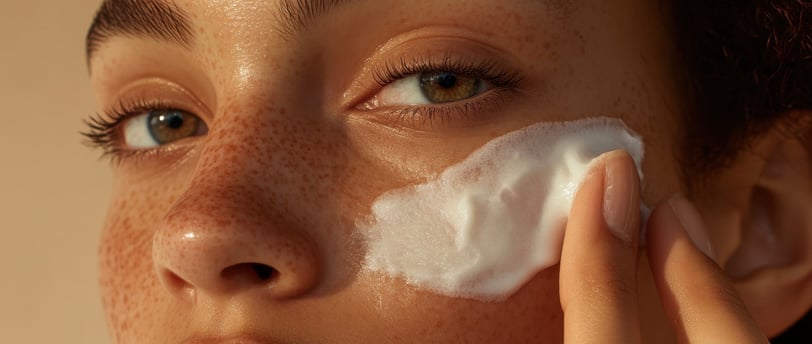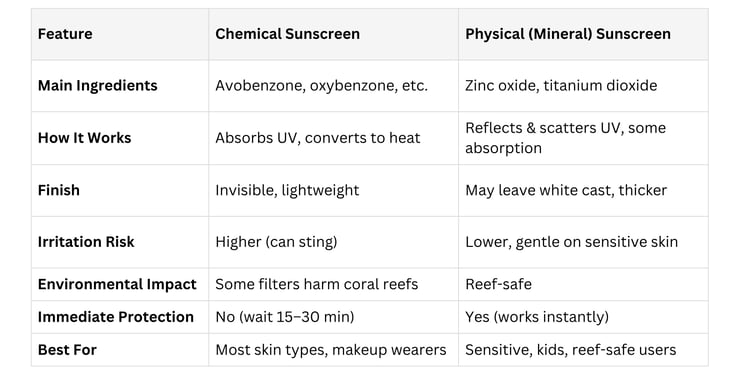Sunscreens: Why We Use Them, How They Work, and What to Choose
Sunscreen is a non-negotiable step in any skincare routine, especially during summer or whenever you’re exposed to daylight. Regular use protects against sunburn, premature aging, and, most importantly, skin cancer. But not all sunscreens are the same—understanding their types, ingredients, and how they work helps you make the best choice for your skin and lifestyle.


Why Do We Use Sunscreen?
Protection from UV Rays: Sunscreen shields your skin from UVA rays (which cause aging and pigmentation) and UVB rays (which cause sunburn and contribute to skin cancer).
Prevents Premature Aging: Daily use helps prevent wrinkles, dark spots, and loss of skin elasticity.
Reduces Skin Cancer Risk: Consistent protection significantly lowers the risk of skin cancers, including melanoma.
Maintains Even Skin Tone: Prevents sun-induced pigmentation and uneven skin tone.
What’s in Sunscreen? (Ingredients & Filters)
Sunscreens contain active ingredients called UV filters, which are divided into two main categories: chemical (organic) filters and physical (mineral/inorganic) filters.
Chemical (Organic) Filters
How They Work: Absorb UV rays and convert them into harmless heat, which is released from the skin.
Common Ingredients: Avobenzone, oxybenzone, octinoxate, octocrylene, homosalate, octisalate, Mexoryl SX, Tinosorb S/M.
Pros: Lightweight, invisible finish (no white cast), easy to apply, often more water- and sweat-resistant, layers well under makeup.
Cons:
Can cause irritation or stinging, especially for sensitive or reactive skin.
Some filters (like oxybenzone and octinoxate) are linked to environmental harm, particularly coral reef bleaching.
Certain filters may be absorbed into the bloodstream, with ongoing research about potential hormonal or systemic effects.
Can increase skin temperature, potentially worsening pigmentation or melasma.
Require 15–30 minutes to become effective after application.
Best For: Most skin types, especially if you want a lightweight feel or wear makeup. Avoid if you have very sensitive, allergy-prone, or heat-reactive skin.
Physical (Mineral/Inorganic) Filters
How They Work: Sit on top of the skin and reflect or scatter UV rays; also absorb a portion of UV and convert it to heat.
Common Ingredients: Zinc oxide, titanium dioxide.
Pros:
Broad-spectrum protection (UVA & UVB), immediate effect after application.
Less likely to cause irritation or stinging—ideal for sensitive, acne-prone, or children’s skin.
Safe for marine environments and coral reefs.
Does not absorb into the bloodstream.
Cons:
Can leave a visible white cast, especially on darker skin tones (though tinted and micronized formulas help).
Thicker texture, can feel heavier or greasy.
May rub off more easily with sweat or water, requiring more frequent reapplication.
Best For: Sensitive, acne-prone, or children’s skin; those with rosacea, eczema, or allergies; anyone seeking reef-safe sun protection.
Forms of Sunscreen
Creams: Best for dry skin, face, and body.
Gels: Good for oily or acne-prone skin, scalp, or hairy areas.
Sticks: Convenient for touch-ups, lips, around the eyes, or on-the-go.
Sprays: Easy for large areas or quick reapplication, but must be rubbed in for even coverage.
Fluids/Essences: Lightweight, great under makeup or for oily skin.
How to Use Sunscreen
Apply generously: Use enough to cover all exposed skin (about a shot glass for the body, half a teaspoon for the face and neck).
Reapply every 2 hours: Especially after swimming, sweating, or towel-drying.
Don’t rely on makeup with SPF alone: You’d need much more product than you typically use to reach the labeled SPF.
Layer with other sun protection: Wear hats, sunglasses, and protective clothing, and seek shade when possible.
Chemical vs. Physical Sunscreens: Quick Comparison


Who Should Use Which?
Sensitive, allergy-prone, children, or those with rosacea/eczema: Prefer mineral/physical sunscreens.
Oily, acne-prone, or makeup wearers: Lightweight chemical sunscreens or gel-based mineral formulas.
Outdoor sports/swimming: Water-resistant chemical sunscreens (but be mindful of environmental impact).
Eco-conscious or reef-safe needs: Choose mineral sunscreens.
Final Tips
Choose broad-spectrum SPF 30+ for daily use; higher if you’re outdoors for long periods.
Reapply regularly, and don’t forget overlooked areas like ears, lips, and the back of the neck.
The best sunscreen is the one you’ll use every day—find a texture and formula you enjoy.
Sunscreen is essential for everyone, every day. Understanding the difference between chemical and physical filters helps you pick what’s best for your skin, lifestyle, and the environment. Cream, gel, stick, or spray—just make sure you use enough, reapply often, and combine with other sun-safe habits for the best protection.
